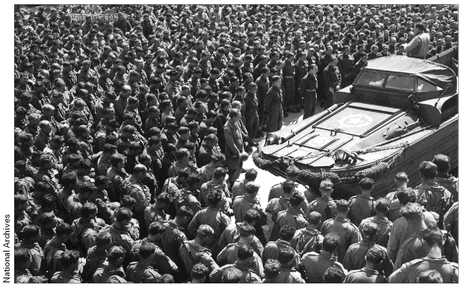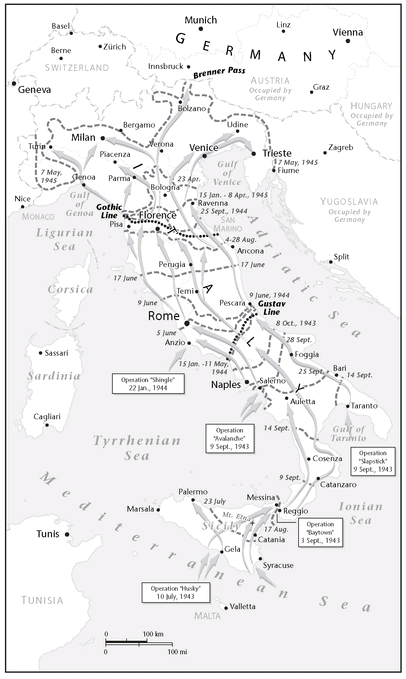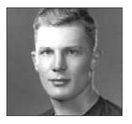War Stories III (21 page)
Authors: Oliver L. North

On 14 April 1945, the day that Bob Dole was wounded, the 10th Mountain Division breached the German defensive line and opened a hole for other Allied troops to pour into northern Italy. But it came at a terrible cost. Of the 19,734 soldiers who served with the 10th Mountain Division in Italy, nearly 5,000 were casualtiesânearly a third of them on the day that 2nd Lt. Bob Dole fell. His regiment lost 370 men killed in action, 1,427 wounded, and three who were captured and made POWs. But the seven-day offensive reached its goal, breaking the back of German resistance in Italy.
Â
10th Mountain Division in Italy.


Thanks to the courage of the Mountaineers, the Allies were able to cut off a German retreat into Austria and sweep through to Trieste, Yugoslaviaâwhere Mark Clark's army met the advance force of Marshall Tito's Yugoslav army. By then, the man responsible for so much death and destruction in his homeland of Italy was dead. On 28 April 1945, Italian Communist partisans captured Benito Mussolini, his mistress, and a dozen other fascists near Lake Como, as they were attempting to flee to Switzerland. They were all promptly executed.
The twenty-two-month-long battle for the boot had tied upâand eventually destroyedâmore than a score of German divisions. Though the bloody Anzio-Cassino battles would turn out to be the most costly killing field in the European theater, the Germans who fought there could otherwise have been used against the Allies in France or later on, in Germany.
CHAPTER 8
WAR IN THE SKIES 1941â1945
I
n the summer of 1939, when World War II began in Europe, the entire United States Army Air Corps consisted of fewer than 1,200 combat aircraft, and the U.S. Navy had less than 900. These planesâfighters, transports, bombers, and patrol aircraftâwere spread from the Philippines to the U.S. East Coast. That same summer, Adolf Hitler's Luftwaffe massed more than 4,000 combat aircraft for the attack on Poland.
n the summer of 1939, when World War II began in Europe, the entire United States Army Air Corps consisted of fewer than 1,200 combat aircraft, and the U.S. Navy had less than 900. These planesâfighters, transports, bombers, and patrol aircraftâwere spread from the Philippines to the U.S. East Coast. That same summer, Adolf Hitler's Luftwaffe massed more than 4,000 combat aircraft for the attack on Poland.
The disparities in air power had been growing since Hitler came to power. By 1935, Germany's reinvigorated armament factories were turning out modern, low-wing fighters and multi-engine bombers. During the Spanish Civil War, from 1936 to 1938, hundreds of German pilots gained valuable combat experience that would benefit the Luftwaffe when war in Europe began.
U.S. military planners were not ignorant of these realities. Air power advocates were simply unable to convince isolationists in Congress to appropriate sufficient funds for building a modern air force. In the midst of the Great Depression, expenditures for military aircraft and training pilots was problematic even though the employment of aircraft in World War Iâfirst for reconnaissance and observation, then as a means of
supporting armies on the ground with bombs and gunsâhad galvanized the imagination of strategic thinkers around the globe.
supporting armies on the ground with bombs and gunsâhad galvanized the imagination of strategic thinkers around the globe.
In Italy, Giulio Douhet postulated in 1921 that future wars could be won by airpower alone, employing massive bombing attacksânot against an adversary's front lines, but against the enemy's cities and war production centers. British, Japanese, and German aircraft designers, military officers, and political leaders seized on Douhet's theories to start modernizing their respective air forces.
In the United States, the most outspoken proponent of air power was U.S. Army Air Corps Brigadier General Billy Mitchell. In July 1921, with scores of politicians and military brass looking on and cameras documenting the event, Mitchell's aircrewsâflying WWI-era aircraftâbombed a group of obsolete American and captured German vessels anchored off the Virginia Capes. Though the “unsinkable” battleship
Ostfriesland
went to the bottom, the demonstration failed to convince opponents that America needed a large, independent air force.
Ostfriesland
went to the bottom, the demonstration failed to convince opponents that America needed a large, independent air force.
Two years later, in a 1923 report that he described as “the masterpiece” of his career, Mitchell predictedânearly two decades
before
Pearl Harborâthat a Pacific war would begin with a naval and air attack on Pearl Harbor at 7:30 a.m. on a Sunday morning! He was off by just twenty-five minutes.
before
Pearl Harborâthat a Pacific war would begin with a naval and air attack on Pearl Harbor at 7:30 a.m. on a Sunday morning! He was off by just twenty-five minutes.
But Billy Mitchell's unwavering and assertive manner made him more adversaries than allies. He resigned from the military in 1926 after being exonerated in a court martial for insubordination. He died ten years laterâstill advocating the need for a modern, independent Air Force.
Throughout the 1930s, opponents of military expenditures in the midst of the Great Depression pointed to the two vast oceans that protected the continental United States from attack by enemy bombers. But as Europe and Asia edged closer to conflagration, Roosevelt was able to convince Congress to start building small numbers of more modern fighters and bombers. That also required that pilots, aircrews, mechanics, and aircrews be trained to fly and maintain them.
By the time Hitler invaded Poland in 1939, new designs for modern fighters and bombers were coming off the drawing boards and U.S. aircraft
companies were being granted small contracts for prototypes to be tested by the Navy and the Army Air Corps. Equally important, thousands of young American men were enrolled in government-subsidized civilian pilot training.
companies were being granted small contracts for prototypes to be tested by the Navy and the Army Air Corps. Equally important, thousands of young American men were enrolled in government-subsidized civilian pilot training.
Many of those who sought to fly before Pearl Harbor were inspired by the accomplishments of solo pilots like Charles Lindbergh and the heroic exploits of World War I pilots. Articles, books, and movies about Erich von RichtoffenâGermany's “Red Baron”âand America's leading “ace”âformer race car driver Eddie Rickenbackerâcaptured the imagination of millions.
Those who flew small, one-seat, single-engine fighters were depicted as modern incarnations of ancient knightsâdoing battle one-on-one. Instead of four-legged steeds, these warrior-pilots had sleek, lethal machines, powerful engines, and the ability to twist, turn, climb, and dive through blue sky.
For tens of thousands of young American men, these were alluring images in the midst of the privations of the Great Depression. Nearly all of those who volunteeredâand could pass the demanding physical and eyesight requirements for pilot trainingâknew that Rickenbacker had twenty-six “kills” and that the Red Baron had eighty. Though few would admit it at the time, most of them nurtured the idea of becoming an “ace”âand knew that such a designation required five air-to-air kills.
In 1939 and 1940, several hundred young aviators left the United States for England, China, and Canadaânot to
avoid
the war, but to test their proficiency and courage against the Germans and Japanese. Americans serving with the RAF “Eagle Squadron” and Claire Chennault's “Flying Tigers” quickly learned that the enemy aircraft and pilots they went up against were tough adversaries. Becoming an “ace” turned out to be a lot tougher than some had thought.
avoid
the war, but to test their proficiency and courage against the Germans and Japanese. Americans serving with the RAF “Eagle Squadron” and Claire Chennault's “Flying Tigers” quickly learned that the enemy aircraft and pilots they went up against were tough adversaries. Becoming an “ace” turned out to be a lot tougher than some had thought.
Robin Olds was a second-year cadet at West Point when the Japanese bombed Pearl Harbor. The son of a WWI ace, he had heard of his father's exploits in open cockpit aircraft over Franceâand had long ago decided to become a pilot. Second Lieutenant Olds arrived in England in May 1944, after graduating with honors from the military academy and flight school.
His first assignment was to help protect the Normandy landings from German air attack. Olds dutifully attacked ground targets, but he was at heart a fighter pilot, and looked forward to the challenge of meeting the enemy in air-to-air combat.
His first assignment was to help protect the Normandy landings from German air attack. Olds dutifully attacked ground targets, but he was at heart a fighter pilot, and looked forward to the challenge of meeting the enemy in air-to-air combat.
LIEUTENANT ROBIN OLDS, USAAF
Over Occupied France
21 September 1944
21 September 1944

Dad took me up on my eighth birthday in a biplane with an open cockpit. I still get a thrill thinking about it. From the moment I felt the breeze on my face, I wanted to fly.
I remember Sunday, December 7, 1941âwhen one of my classmates at West Point came running up to me excitedly saying, “They bombed Pearl Harbor!”
“Who did?” I asked.
“The Japanese,” he saidâas though I should have known.
After graduation and flight school, I was sent to England, where our squadron flew missions over Normandy. By August, I'd been flying combat missions for more than three months and never saw an enemy airplaneâbut then in August, our zone of operation shifted and all that changed. Flying alone over France, I got a chance to smoke two German Focke Wulf 190s.
Just eleven days later another pilot and I, flying in P-38s, came upon a gaggle of fifty Messerschmidt 109s, and I radioed my group leader and said, “I'm going after some bandits, headed north.” I could have given him more details, but hell, they were
my
bandits. I didn't want to share them with anybody.
my
bandits. I didn't want to share them with anybody.
The first one still hadn't seen me when I slid in behind him for the kill.
But just as I lined up my gun sight and was about to pull the trigger, both engines quit on my plane. I was so excited I had forgotten to switch fuel tanks after dropping my empty tanksâbut I shot him down anyway. To this day, I may be the only fighter pilot in the history of aerial warfare that ever shot down an enemy airplane while flying a “glider.”
After getting my engines restarted, I downed another ME-109, and then rolled into a dive. As I got closer to the ground, my controls froze. I remember saying to myself, “You're just going straight down and crash, and that'll be it.”
But I managed to pull out at the last instant and just barely cleared the ground. So I said, “This boy has had itâthat's enough. No more fighting now, I just want to go home.”
As I started my turn for home, I looked over my left shoulder and there was another ME-109 shooting at me. And I thought, that's not fairâcan't he see that I'm scared and want to go back to base? I meanâhe's taking an unfair advantage of me.
Instinctively, I pulled a hard break, and that old P-38 of mine shuddered, almost turned, and stopped. The poor 109 pilot overshot my position and I just rolled the wings levelânow he was right in front of me. So I took aim and shot him down.
Then
I went home.
Then
I went home.
The competition in the skies to rack up “kills” was fierce. All claims of air-to-air victories were supposed to be verifiedâeither by another flyer who witnessed the enemy airplane go down, or by gun cameras that provided a permanent visual record of hits and kills. The squadron intelligence officers who tallied the scores would often say, “A picture is worth a thousand words.”
But not all gun camera film could be recovered. Charles “Chuck” Yeager had such an experience over France. Yeager was, by his own description, “just a West Virginia farm boy.” Born in 1923, he never even got close to an airplane until he was eighteen. His first flight didn't go very well.
LIEUTENANT CHARLES YEAGER, USAAF
Over Occupied France
23 September 1944
23 September 1944

I enlisted in September of '41, just after finishing high school, and became a ground crewman on AT-6s. I was on liberty that Sunday and heard on the radio that the Japs had bombed Pearl Harborâand that we were to report to our base.
A few days later I applied for pilot training and they took us up for a familiarization flight. As soon as we took off, motion sickness took over and I puked all over the airplane. When we got back on the ground, I said to myself, “Man, you've applied for pilot training. You've made a big mistake.”
After months of pilot training in the States, I finally arrived in Europe in the fall of '43 with the 357th Fighter Group. In the spring of '44 we were given new planes, P-51 Mustangs. With the P-51 we had eight hours of endurance and could fly all over Europeâand we did.
On 4 March 1944 I was on my seventh mission in the skies over Germany, flying my P-51 Mustangânicknamed “Glamorous Glen,” after my wife, Glennisâwhen I spotted a German ME-109 flying alone, below me. Combat flying is a matter of self-survival. If you don't get him, he'll get you. I wanted to get him before he got me.
I pulled the P-51 up and into a big roll and slid up under the ME-109. He never saw me. I got in to about 200 yards, opened fire, and he blew up. It was my first kill, but the very next day, in a wild dogfight over France, I was on the losing end. A burst of German 20 mm shells took
me
down.
me
down.
First thing I knew the prop came off my airplane, then part of the left wing, and then the canopy. So my airplane and I parted company. I came out of the plane, probably around 18,000 feet, and free-fell for awhile because it had been rumored that the Germans might strafe you in your
parachute. I pulled the D-ring on my chest, the chute popped open, and as I swung by the top of a pine tree, I grabbed it and let myself down.
parachute. I pulled the D-ring on my chest, the chute popped open, and as I swung by the top of a pine tree, I grabbed it and let myself down.
Now there's not a German in the world who can catch a West Virginian in the woods. So when I hit the ground, I rolled up my parachute and took off. The next day, I made contact with a French woodcutter. I couldn't speak French and he couldn't speak English. He went to get a guy who could, and he asked me, “What do you want to do?”
I told him, “I want to get into Spain. It's a neutral country.”
I spent a month on the run with the French underground, before they turned me and another downed pilot loose in the Pyrenees Mountains just north of the Spanish border. It took us about four days to get across, with no food to speak of.
After nearly two months in Spain I finally got back to Englandâthe first pilot from my fighter group to return after being shot down. Everyone wanted to know how I had evaded the Germans so long. I told them that the French resistance hid me in bordellos because the Germans weren't allowed to visit prostitutes. It was a tall tale, of course, but some of the guys in the group said that they were going to bail out the next day to check it out for themselves.
To protect the French resistance, downed pilots who escaped weren't supposed to go back into combat for fear that if they were captured they might divulge the underground's secrets. But a few weeks after I got back, I met General Eisenhower. And I told him that I didn't want to go home. He asked, âWhy?'
I told him, “It's because I haven't done my job yet, General.”
As a result, on 12 October 1944, I was back in the huntâand not long afterwards, spotted sixteen ME-109s. I came up within about 200 yards behind them and opened up on the tail end 109. He broke, and ran into his section leaderâand they
both
exploded. Then all hell broke loose.
both
exploded. Then all hell broke loose.
There were airplanes going every which way. One of 'em started to turn and get inside me so I let him have it. It was the kind of shot where
you have to remember to lead your targetâthe kind of deflection shooting you do when bird hunting.
you have to remember to lead your targetâthe kind of deflection shooting you do when bird hunting.
When he blew up, his wing-man cut his power back, and tried to get behind me. But when he did that, I cut my own power, skidded out, kicked right rudder, and man, just sawed him in two with those six .50-caliber guns. By then I was low on fuel and ammo but I then saw another guy headed for the deck. So I followed him down, and blew him up. There was no point going home with ammo in the guns.
Other books
The Drifter by Kate Hoffmann
The Perfect Affair by Lutishia Lovely
The World Inside by Robert Silverberg
Mistress of His Revenge (Bought by the Brazilian #1) by Chantelle Shaw
Rancher Wants a Wife by Kate Bridges
The Submission of a Mafia Princess by Sandra Bunino
The Eternal World by Farnsworth, Christopher
Gentling the Cowboy by Ruth Cardello
The Canary Caper by Ron Roy